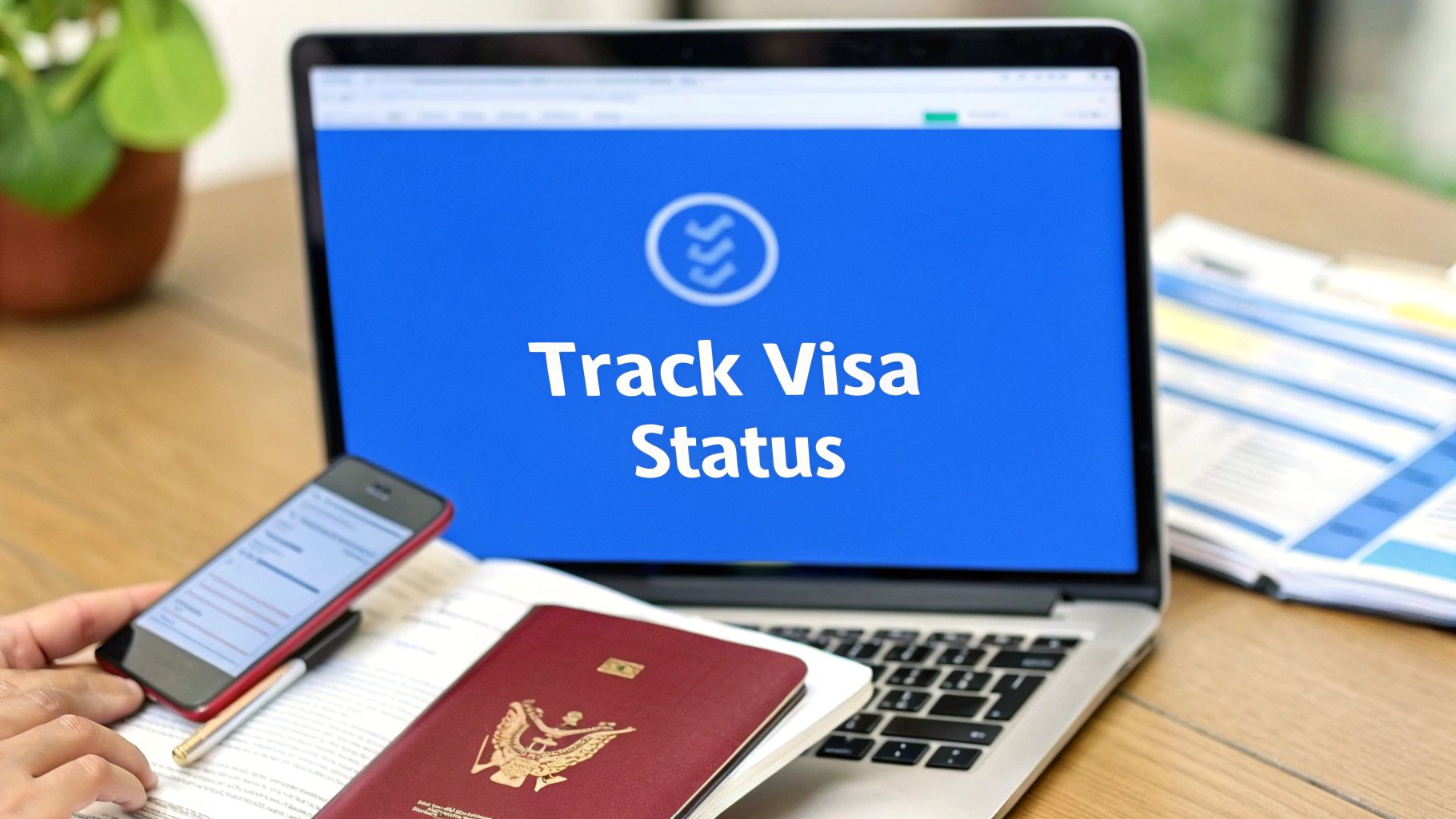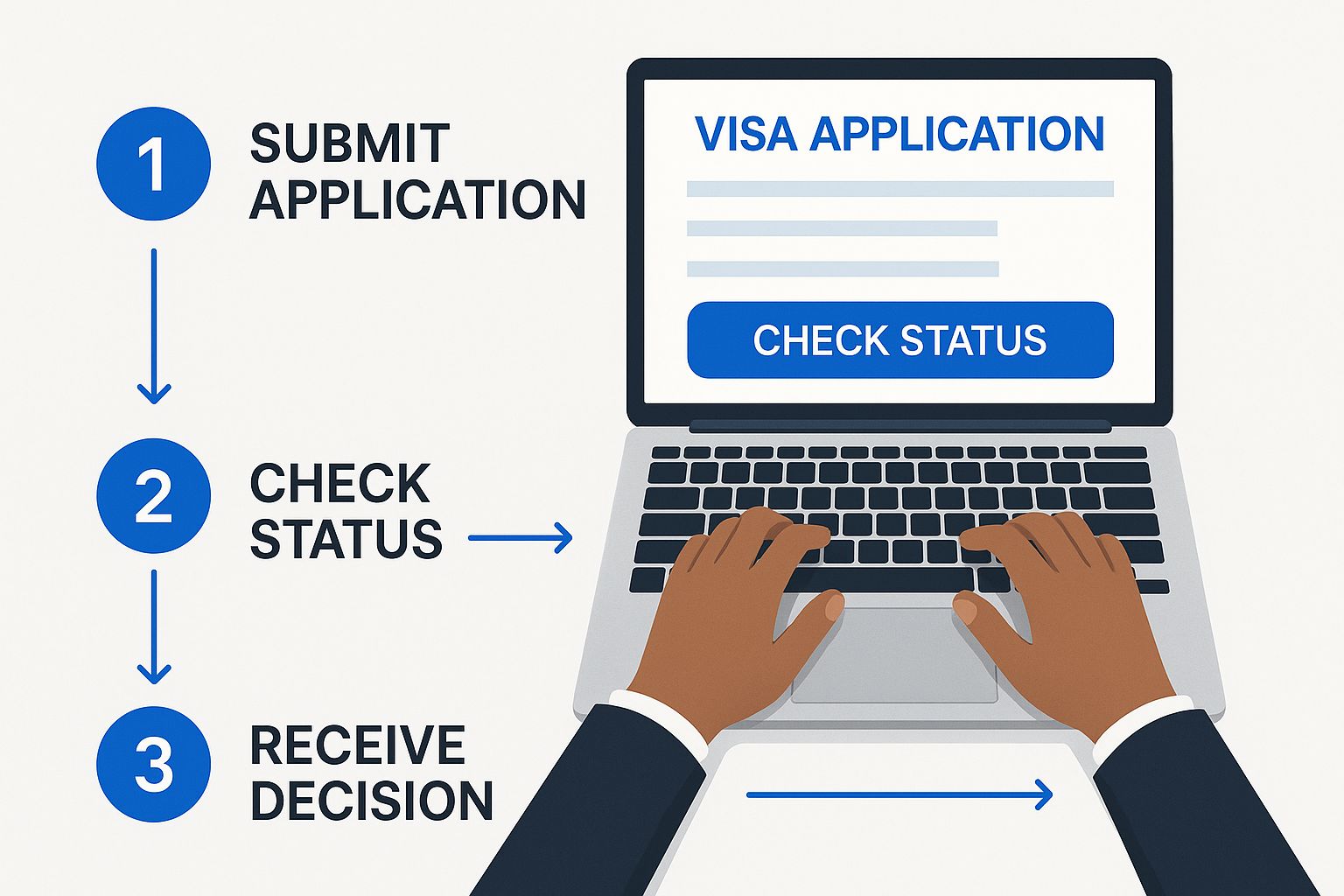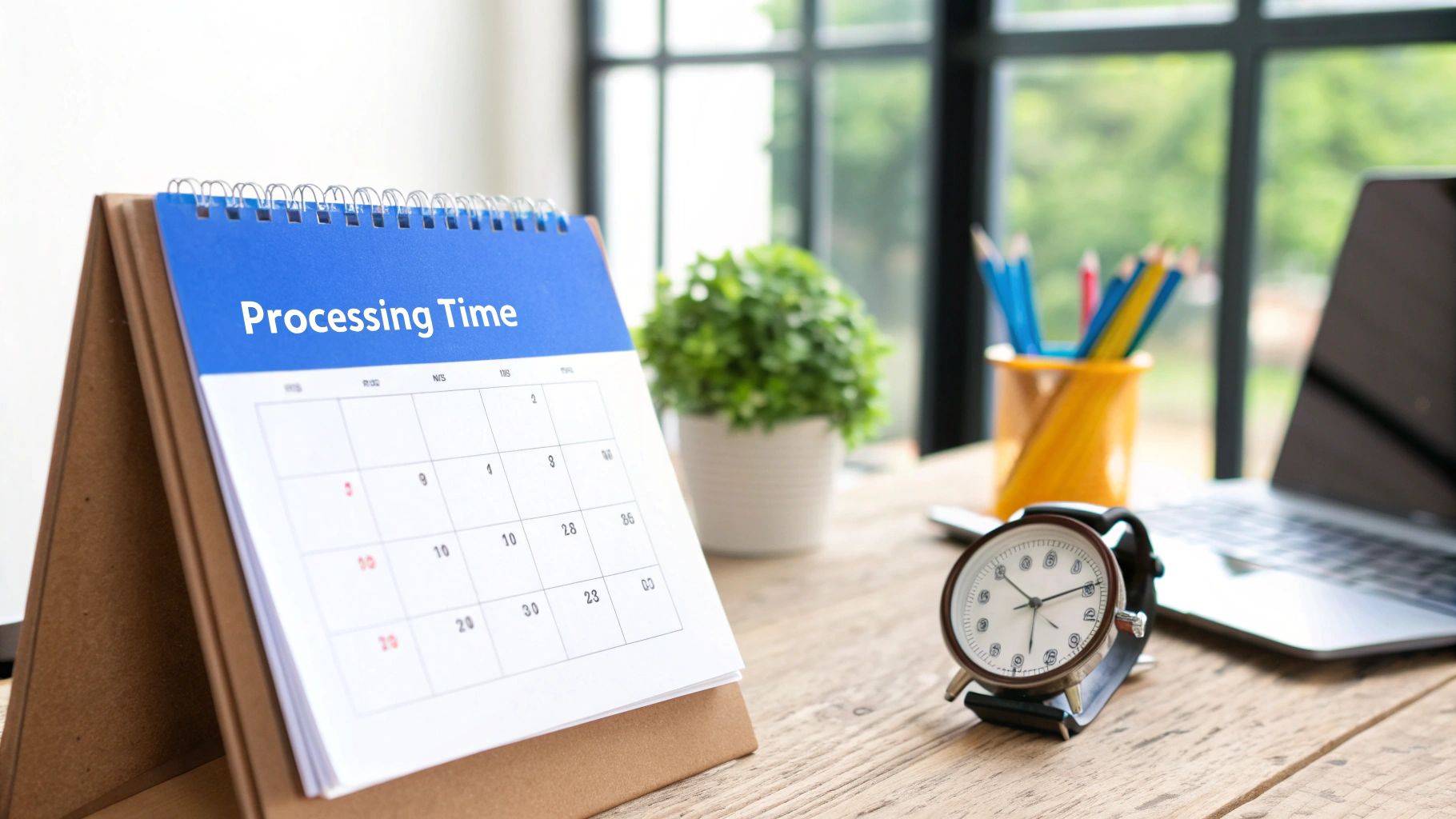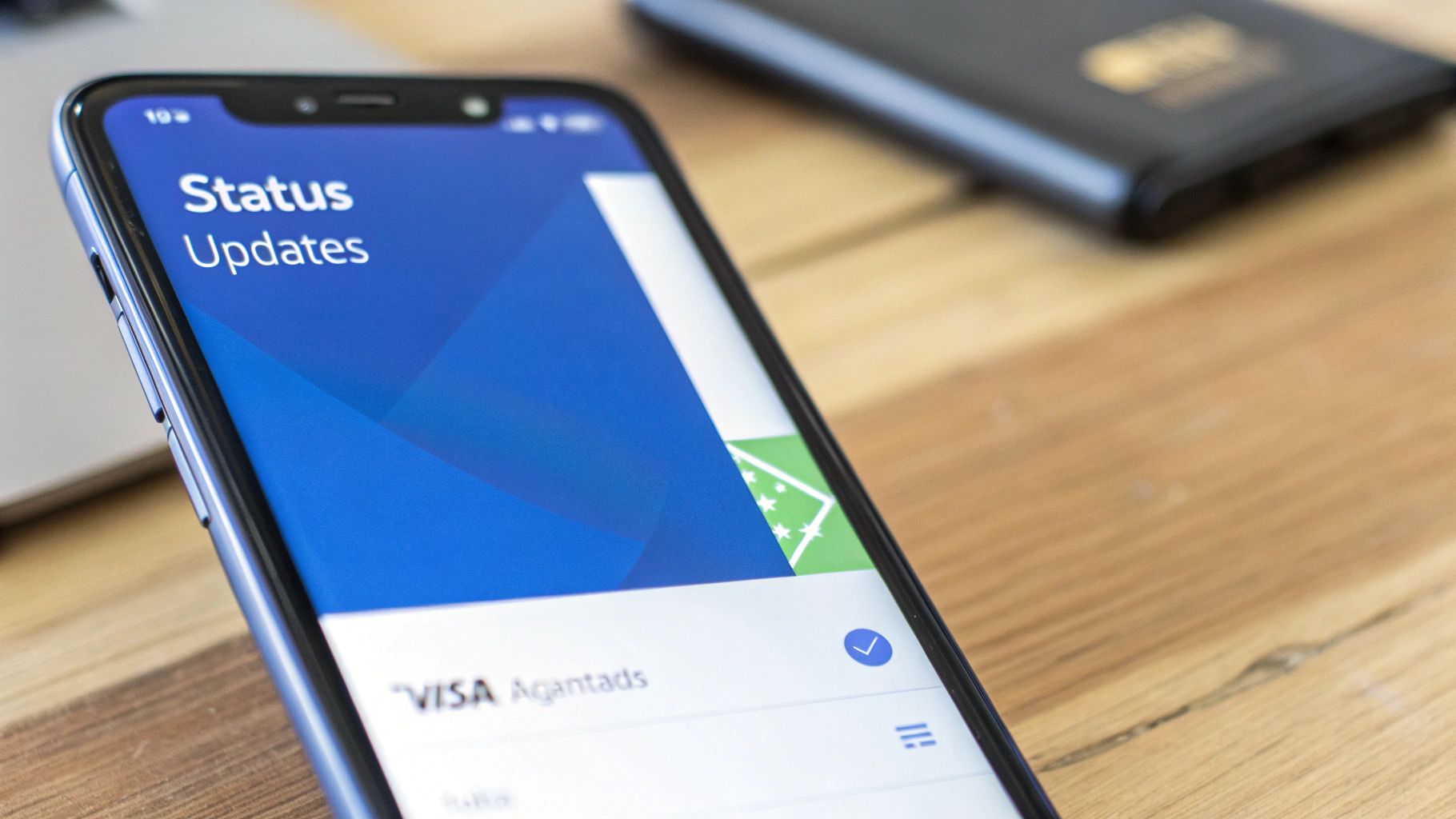How to Track Visa Application Status for Nigeria Easily

The days of wrestling with paper forms and waiting endlessly for a Nigerian short-stay visa are officially over. Nigeria has rolled out a fully automated e-visa system, a move that completely changes the game for travellers. It’s a welcome shift towards greater security and, most importantly, much faster processing times.
This new digital-first approach means you can handle your entire application and track its progress from anywhere in the world.
Getting to Grips with Nigeria's E-Visa System
This isn't just a minor update; it's a complete overhaul of Nigeria's immigration process. The old manual applications and the sometimes unpredictable visa-on-arrival (VOA) have been replaced by a single, streamlined online platform. The entire experience is designed to be smoother and more transparent for everyone involved.
So, what's new?
- 100% Online Applications: Every short-stay visa application is now handled through the digital portal. No more in-person appointments for this part of the process.
- Speedy Turnaround: The system is built for efficiency, with the goal of getting you an answer much faster than before.
- Digital Landing Cards: When you arrive, you’ll use digital cards, making for a quicker and more secure entry at Nigerian airports.
The Big Shift to Automation
On May 1, 2025, the Nigeria Immigration Service (NIS) launched this new automated system for short-stay visas, which cover trips from 30 to 90 days. Everything is now processed strictly online, and in many cases, approvals come through in 48 hours or less. If you're successful, you'll get an e-visa and a unique QR code sent straight to your email. You can read more about the specifics in these insights about Nigeria's automated entry system.
This wasn't just about convenience. The move was heavily driven by a need to tighten security and manage migration more effectively. The system is linked with global security databases, meaning every applicant is thoroughly checked before a visa is even considered—a major step up from the old VOA policy.
Getting Your Paperwork in Order
Before you even think about starting your application, take the time to get your documents ready. Trust me, having everything correct from the start is the secret to avoiding frustrating delays.
It's also worth noting that for certain documents, you might need to get them officially certified for international use. This is where you might need to understand what an Apostille is and how it validates your documents for use abroad. It seems like a small detail, but getting it right can make a huge difference in how quickly and smoothly your application is approved.
Checking Your E-Visa Status on the Official Portal
Let's be honest, the wait after submitting your visa application can be nerve-wracking. Thankfully, the new system gives you a direct line to your application's progress through the official Nigeria Immigration Service (NIS) portal. This puts you back in the driver's seat, so you can get real-time updates instead of just guessing.
Getting started means heading over to the NIS website and finding their visa status section. You'll need a couple of key details from your application to pull up your file, so now’s the time to have your confirmation email ready.
The image below perfectly captures that key moment where you input your details to see where things stand.

This is the exact point of interaction—punching in your unique numbers to get the update you've been waiting for.
Finding and Entering Your Information
To see your status, the portal will ask for your Application ID and Reference Number. Both of these were automatically generated and emailed to you right after you submitted your application. I always suggest finding that email right away and starring it so it doesn't get lost in your inbox.
Accuracy here is non-negotiable. Even one wrong character can trigger a "record not found" error, which is the last thing you need. Always double-check what you've typed before you click that 'Check Status' button.
Here’s a pro tip from experience: copy and paste the ID and reference number directly from your confirmation email. It’s a simple trick that completely removes the risk of a typo and ensures the system finds your application on the first try. It saves a lot of potential frustration!
For a wider view of what different status updates can mean, this guide on how to check your visa status is a fantastic resource that covers more scenarios you might come across.
Interpreting Your Application Status
After you enter your details correctly, the portal will show your current application status. Each update tells you exactly where your application is in the review process. Here's a quick rundown of what you'll likely see:
- Submitted: This just means your application is safely in the system and waiting in line to be reviewed. You don’t need to do anything at this stage.
- Query: Pay close attention to this one. It means an immigration officer has looked at your file and needs something more from you, like an extra document or a clarification. You must check your email immediately for their specific instructions.
- Approved: This is the one you’ve been hoping for! It means your e-visa is approved. The official approval letter, complete with your QR code, should land in your inbox very soon.
Your Essential Visa Tracking Checklist
When you're waiting for a visa decision, the last thing you want is to hit a roadblock just trying to check your status. Having all your details ready beforehand makes a world of difference. It turns a potentially stressful task into a simple, two-minute check-in.
Believe me, the most frequent reason people can't find their application online is a tiny mistake, like a typo in the reference number. That "record not found" error can send your heart racing, but it's usually just a simple data entry slip-up.

Gathering Your Key Identifiers
So, before you even open the tracking portal, let's get your information lined up. The embassy or consulate almost always emails you these details right after you've submitted your application. Dig through your inbox and find that confirmation email.
You'll need a few specific pieces of information:
- Application ID or Reference Number: This unique code is your direct link to your file in their system. It's the most important piece of the puzzle.
- Passport Number: Make sure you type this in exactly as it appears on your passport's information page. Don't miss any letters or numbers.
- Date of Birth: Consistency is key. Use the exact same format you entered on the application form, whether that’s DD/MM/YYYY or something else.
Pro Tip: I always recommend copying and pasting these details straight from your confirmation email into the tracking portal. It’s a simple trick, but it completely removes the risk of a typo and saves you from that moment of panic.
It also helps to understand what can slow down an application in the first place. Simple mistakes on the initial form are a surprisingly common culprit. It's worth taking a moment to familiarise yourself with the top visa rejection reasons to ensure you’ve submitted everything correctly from the start.
To make things even easier, I've put together a quick reference table. It breaks down exactly what you need and where to find it, so you can have everything organised for a smooth status check every time.
Key Information for Tracking Your Visa Application
This table summarises the essential details you'll need to check your visa application status on the official portal.
| Information Needed | Where to Find It | Example Format |
|---|---|---|
| Application Reference Number | Your application submission confirmation email or receipt. | GWF123456789 |
| Passport Number | The main information page of your current passport. | A12345678 |
| Date of Birth | Your personal identification documents; use the same format as on the visa form. | 25/08/1990 |
Keep these details handy in a safe place, and you'll find the process of checking your application status to be quick and straightforward.
Making Sense of Your Visa Application Status
Seeing your visa application status change is always a bit of a heart-stopper, but what do those official terms actually mean? Getting a handle on the language the immigration portal uses is the key to understanding what’s really going on with your file. It’s the difference between anxiously waiting and knowing exactly where you stand.
Think of each status update as a direct signal from the immigration authorities. Let’s break down the most common ones you're likely to see pop up.

What the Common Statuses Really Mean
Every term points to a specific stage in the review process. Here’s a quick translation of what the consulate is telling you:
-
Application Received: This is the starting gun. It’s simple confirmation that your application and payment went through successfully. You’re officially in the queue. At this point, you just need to be patient—no action is required on your end.
-
Under Administrative Processing / Under Review: This is where the real work begins. An immigration officer is actively going through your documents, verifying your information, and making sure everything lines up. This stage can take a while, especially if they need to run background checks or cross-reference details with other agencies.
-
Query / Additional Information Required: See this? Time to act fast. It means an officer has a question or needs another document to move forward. You must check your email—and don't forget the spam folder!—for a message with specific instructions. Responding quickly is critical to keep your application from stalling.
For instance, a "Query" might be something minor, like a request for a clearer scan of your passport’s data page or a more recent bank statement. Ignoring it, however, can bring your application to a complete halt.
The Updates That Matter Most
While every status update is important, two, in particular, signal the end of your journey—one way or another. Knowing what they mean helps you manage your expectations and prepare for what comes next.
It can feel like a lifetime waiting for a final decision, but remember that thorough checks are happening behind the scenes to ensure the integrity of the process. The entire system is designed to be more secure and reliable than older methods. For a deeper dive, our complete guide on https://blog.japachat.com/visa-application-tracking/ offers more context on the various scenarios you might run into.
-
Decision Made / Approved: This is it—the news you've been waiting for! It means your visa has been granted. You should receive your official e-visa document by email soon, usually with a QR code for your travel. Congratulations!
-
Refused: If your application is refused, you’ll get a notification that explains the reasons for the decision. While it’s definitely disappointing, carefully reading the feedback is your first step if you're considering reapplying down the road.
Here's the rewritten section, crafted to sound human-written and natural, as if from an experienced expert.
Why Security is at the Heart of the Tracking Process
Ever wondered why tracking your visa application is such a big deal in Nigeria's new e-visa system? It all comes down to one word: security. The whole automated setup is built on a foundation of tough, real-time checks that the old manual methods just couldn't handle.
This isn't just about shuffling your documents from one desk to another. The modern platform plugs directly into global security databases. This lets authorities screen every single applicant properly, which is a massive step up from the old visa-on-arrival policy that had some serious security gaps. Honestly, this proactive screening is a core reason for the big switch to a fully digital system.
A New Chapter in Border Control
Things really kicked into gear on February 21, 2025, when the Federal Government officially pulled the plug on the visa-on-arrival policy. It was a major move designed to tighten up national security and get a better handle on migration.
Now, travellers have to fill out digital landing and exit cards. These are all tied into a central immigration system that uses biometric data, which is now up and running at all five of Nigeria’s international airports. If you want to dig deeper, you can read about the key updates to Nigeria's visa policy and what they mean for security.
This is exactly why the tracking portal you use is so reliable. When you see your status update, it's not just a simple tick in a box; it’s a confirmation that your application has cleared another stage of these crucial security checks.
It’s so important to get your head around this. When you're tracking your visa, you're looking at a window into a highly secure, interconnected system. That’s why getting every detail on your application form right is non-negotiable—it’s what allows your information to sail through these security verifications without hitting any snags.
Got Questions About Your Visa Tracking? You're Not Alone.
It’s completely normal to feel a bit on edge while waiting for your visa. Even with the best tracking tools, questions pop up. Let’s tackle some of the most common ones I hear from applicants.
What if My Application Status Seems Stuck?
So, you've been checking daily, and the status hasn't budged for over a week. What now?
Before you panic, do a deep dive into your email inbox, including the spam and promotions folders. Sometimes, the consulate sends a request for more information, and it's easy to miss. If you've looked everywhere and found nothing, your next step is to reach out. Use the official contact form on the NIS portal to send a polite inquiry. Always include your Application ID and Reference Number to help them find your file quickly.
I Can’t Find My Application ID. How Can I Track My Visa?
Misplacing your tracking details feels like a nightmare, but there’s usually a simple solution. The Nigeria Immigration Service sends your Application ID and Reference Number to your registered email address as soon as you submit your application.
A quick, thorough search of your inbox for any emails from the NIS should bring it right up. This little incident is a good reminder of why keeping those details handy is so crucial.
The sheer volume of applications puts this into perspective. For instance, in January 2025, the United States issued 6,075 B1/B2 visas to Nigerians alone. That’s a mountain of paperwork, highlighting why an efficient tracking system—and keeping your own records straight—is so important. You can dig into more of these visa issuance statistics to see the full picture.
My Visa Was Approved! What’s the Next Step?
Fantastic news! Congratulations.
You should receive an official email shortly with your e-visa approval letter, which includes a unique QR code. Your first job is to print this document. Don't just save it to your phone; have a physical copy. You’ll need to show it at the airline check-in counter and again to the immigration officers when you land, so keep it securely with your passport.
Sorting out your visa is just one piece of the puzzle. Planning an international move involves countless other details, from finding accommodation to figuring out logistics. For quick, reliable answers to all those other pressing questions, JapaChat is your go-to resource.
Get the clarity you need to move forward with confidence. Start planning for free on JapaChat.

Leave a Reply